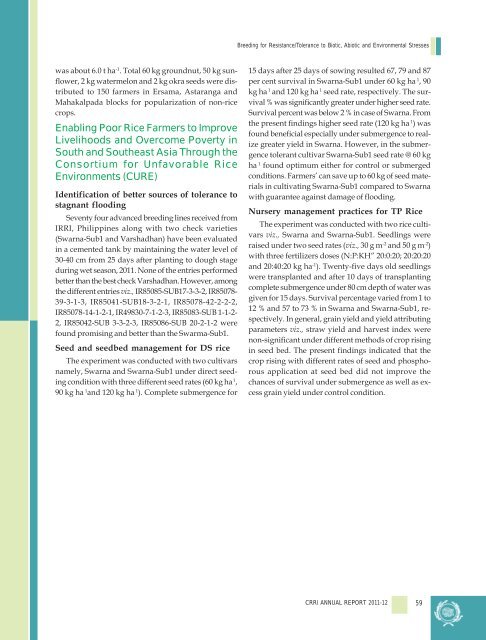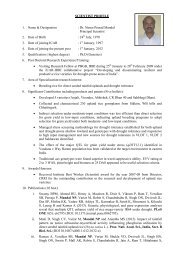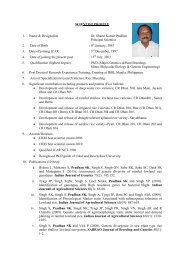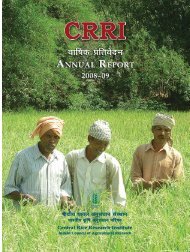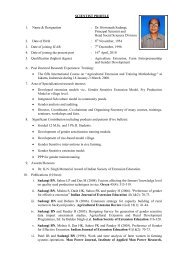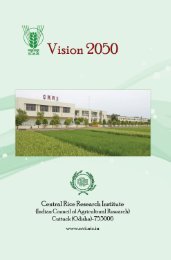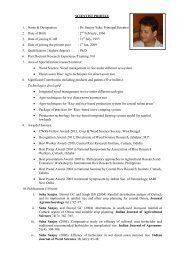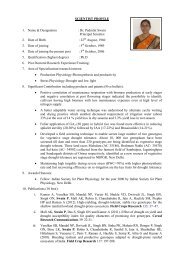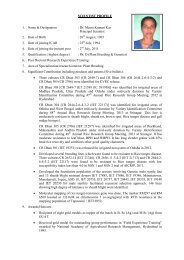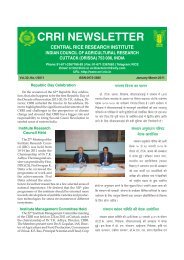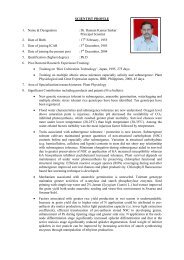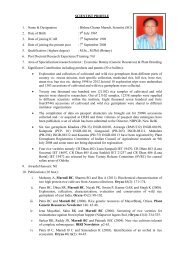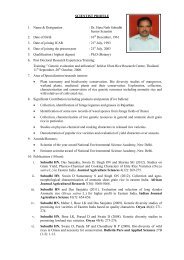Central Rice Research Institute Annual report...2011-12
Central Rice Research Institute Annual report...2011-12
Central Rice Research Institute Annual report...2011-12
You also want an ePaper? Increase the reach of your titles
YUMPU automatically turns print PDFs into web optimized ePapers that Google loves.
Breeding for Resistance/Tolerance to Biotic, Abiotic and Environmental Stresses<br />
was about 6.0 t ha -1 . Total 60 kg groundnut, 50 kg sunflower,<br />
2 kg watermelon and 2 kg okra seeds were distributed<br />
to 150 farmers in Ersama, Astaranga and<br />
Mahakalpada blocks for popularization of non-rice<br />
crops.<br />
Enabling Poor <strong>Rice</strong> Farmers to Improve<br />
Livelihoods and Overcome Poverty in<br />
South and Southeast Asia Through the<br />
Consortium for Unfavorable <strong>Rice</strong><br />
Environments (CURE)<br />
Identification of better sources of tolerance to<br />
stagnant flooding<br />
Seventy four advanced breeding lines received from<br />
IRRI, Philippines along with two check varieties<br />
(Swarna-Sub1 and Varshadhan) have been evaluated<br />
in a cemented tank by maintaining the water level of<br />
30-40 cm from 25 days after planting to dough stage<br />
during wet season, 2011. None of the entries performed<br />
better than the best check Varshadhan. However, among<br />
the different entries viz., IR85085-SUB17-3-3-2, IR85078-<br />
39-3-1-3, IR85041-SUB18-3-2-1, IR85078-42-2-2-2,<br />
IR85078-14-1-2-1, IR49830-7-1-2-3, IR85083-SUB 1-1-2-<br />
2, IR85042-SUB 3-3-2-3, IR85086-SUB 20-2-1-2 were<br />
found promising and better than the Swarma-Sub1.<br />
Seed and seedbed management for DS rice<br />
The experiment was conducted with two cultivars<br />
namely, Swarna and Swarna-Sub1 under direct seeding<br />
condition with three different seed rates (60 kg ha 1 ,<br />
90 kg ha 1 and <strong>12</strong>0 kg ha 1 ). Complete submergence for<br />
15 days after 25 days of sowing resulted 67, 79 and 87<br />
per cent survival in Swarna-Sub1 under 60 kg ha 1 , 90<br />
kg ha 1 and <strong>12</strong>0 kg ha 1 seed rate, respectively. The survival<br />
% was significantly greater under higher seed rate.<br />
Survival percent was below 2 % in case of Swarna. From<br />
the present findings higher seed rate (<strong>12</strong>0 kg ha 1 ) was<br />
found beneficial especially under submergence to realize<br />
greater yield in Swarna. However, in the submergence<br />
tolerant cultivar Swarna-Sub1 seed rate @ 60 kg<br />
ha 1 found optimum either for control or submerged<br />
conditions. Farmers’ can save up to 60 kg of seed materials<br />
in cultivating Swarna-Sub1 compared to Swarna<br />
with guarantee against damage of flooding.<br />
Nursery management practices for TP <strong>Rice</strong><br />
The experiment was conducted with two rice cultivars<br />
viz., Swarna and Swarna-Sub1. Seedlings were<br />
raised under two seed rates (viz., 30 g m -2 and 50 g m -2 )<br />
with three fertilizers doses (N:P:KH” 20:0:20; 20:20:20<br />
and 20:40:20 kg ha -1 ). Twenty-five days old seedlings<br />
were transplanted and after 10 days of transplanting<br />
complete submergence under 80 cm depth of water was<br />
given for 15 days. Survival percentage varied from 1 to<br />
<strong>12</strong> % and 57 to 73 % in Swarna and Swarna-Sub1, respectively.<br />
In general, grain yield and yield attributing<br />
parameters viz., straw yield and harvest index were<br />
non-significant under different methods of crop rising<br />
in seed bed. The present findings indicated that the<br />
crop rising with different rates of seed and phosphorous<br />
application at seed bed did not improve the<br />
chances of survival under submergence as well as excess<br />
grain yield under control condition.<br />
CRRI ANNUAL REPORT 2011-<strong>12</strong><br />
59


